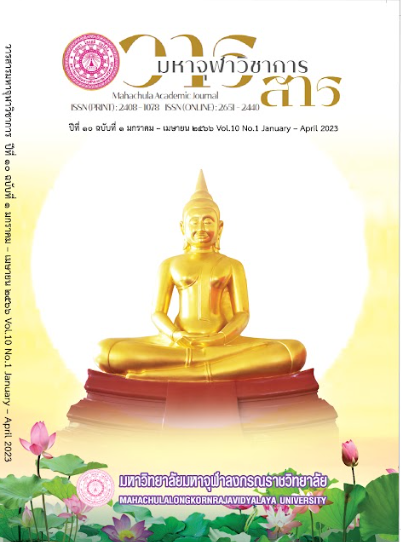An Analytical Study of the Kammaṭṭhāna in the Appamāda Vagga and Citta Vagga
Main Article Content
Abstract
An analytical study of the kammațțhāna (meditation subjects) mentioned in the Appamāda Vagga and Citta Vagga of the Dhammapāda Commentary. The object is three-fold: (i) In order to study the teaching of meditation as it appears in the Buddhist texts. (ii) To study the structure and substance of these particular two chapters. (iii) To analyse the subject of meditation as found in the Appamāda Vagga & Citta Vagga.
This is essentially documentary research.The research reveals that the concept and practice of samatha meditation was already known before the time of the Buddha. The goal was the attainment of jhāna, which was supposed to lead after death to some kind of eternal state of being, together with Brahma - even though this was still within the conditions of samsāra. Only with the arising in the world of the Buddha's Dispensation was made known vipassanā kammațțhāna, the development of which entailed the use of the five khandha, nāma-rūpa, as objects of investigation within the framework of the Three Characteristics of Anicca, Dukkha and Anattā, in order to realise transcendent truth with the attainment of Ariyapuggala. The goal was now Nibbāna, or the way to the complete cessation of Dukkha, cutting the stream of endless cycles of birth and death.Within the framework of the Appamāda Vagga there are a total of nine stories, of which five have been selected for study: (i) Concerning the Lady Sāmāvatī. (ii) Concerning Ven. Cuļapanthaka Thera. (iii) Concerning Ven. Mahā Kassapa. (iv) Concerning the two bhikkhu companions. (v) Concerning a particular monk.The Citta Vagga also comprises nine stories of which, again, five have been selected for study: (1) Concerning Ven. Meghiya Thera. (2) Concerning a particular monk. (3) Concerning Ven. Ukkaņțhita Bhikkhu. (4) Concerning Ven. Sangharakkhita Thera. (5) Concerning Ven. Cittahattha Thera. The Appamāda Vagga presents meditation teaching emphasising heedfulness and the fundamentals of mettā brahmavihāra; ālokakasiņa; vedanānupassanā satipațțhāna; the principle of the Three Characteristics; undertaking the austerities of monkhood; and the way of abandoning all bondage. It describes vipassanā from a basis of samatha. The Citta Vagga has more emphasis on cittānupassanā satipațțhāna: ie. being aware of the mental states that change constantly in response to sense impressions; the use of wisdom to supervise and care for the mind. Meditation is described from the perspective of nurturing the quality of mind that enables it to stay with the meditation object. The Appamāda Vagga & Citta Vagga together include teachings on aspects of all four Satipațțhāna: ie. (1) mindfulness of the bodily condition. (Kãyãnupassanã Satipatthãna). (2) mindfulness of states of feeling. (Vedanãnupassanã Satipatthãna). (3) mindfulness of states of thought. (Cittãnupassanã Satipatthãna). (4) mindfulness of mental states arising at the mind-base. (Dhammãnupassanã Satipatthãna).
Article Details

This work is licensed under a Creative Commons Attribution-NonCommercial-NoDerivatives 4.0 International License.
References
ปินปภา โสภณ. “ประสิทธิผลของการปฏิบัติวิปัสสนากรรมฐานที่มีต่อการเปลี่ยนแปลงชีวิตของผู้ปฏิบัติวิปัสสนากรรมฐาน ณ วัดตาลเอน จังหวัดพระนครศรีอยุธยา”. วิทยานิพนธ์ศิลปศาสตรมหาบัณฑิต สาขาวิชาไทยศึกษา. โครงการบัณฑิตศึกษา: มหาวิทยาลัยราชภัฏธนบุรี, ๒๕๕๘.
พระธรรมปิฎก (ป. อ. ปยุตฺโต). พจนานุกรมพุทธศาสตร์ ฉบับประมวลธรรม. พิมพ์ครั้งที่ ๙. กรุงเทพมหานคร: โรงพิมพ์มหาจุฬาลงกรณราชวิทยาลัย, ๒๕๔๐.
พระพุทธโฆสาจารย์. คัมภีร์วิสุทธิมรรค (ฉบับรวมเล่ม). แปลและเรียบเรียงโดย สมเด็จพระพุฒาจารย์ (อาจ อาสภมหาเถร). พิมพ์ครั้งที่ ๑๔. พิมพ์ในประเทศจีน, ๒๕๖๒.
มหาจุฬาลงกรณราชวิทยาลัย. พระไตรปิฎกภาษาไทย ฉบับมหาจุฬาลงกรณราชวิทยาลัย. กรุงเทพมหานคร: โรงพิมพ์มหาจุฬาลงกรณราชวิทยาลัย, ๒๕๓๙.
มหาวิทยาลัยมหาจุฬาลงกรณราชวิทยาลัย. ธรรมบทอรรถกถา ฉบับมหาจุฬาลงกรณราชวิทยาลัย. กรุงเทพมหานคร: โรงพิมพ์มหาจุฬาลงกรณราชวิทยาลัย, ๒๕๕๖.

